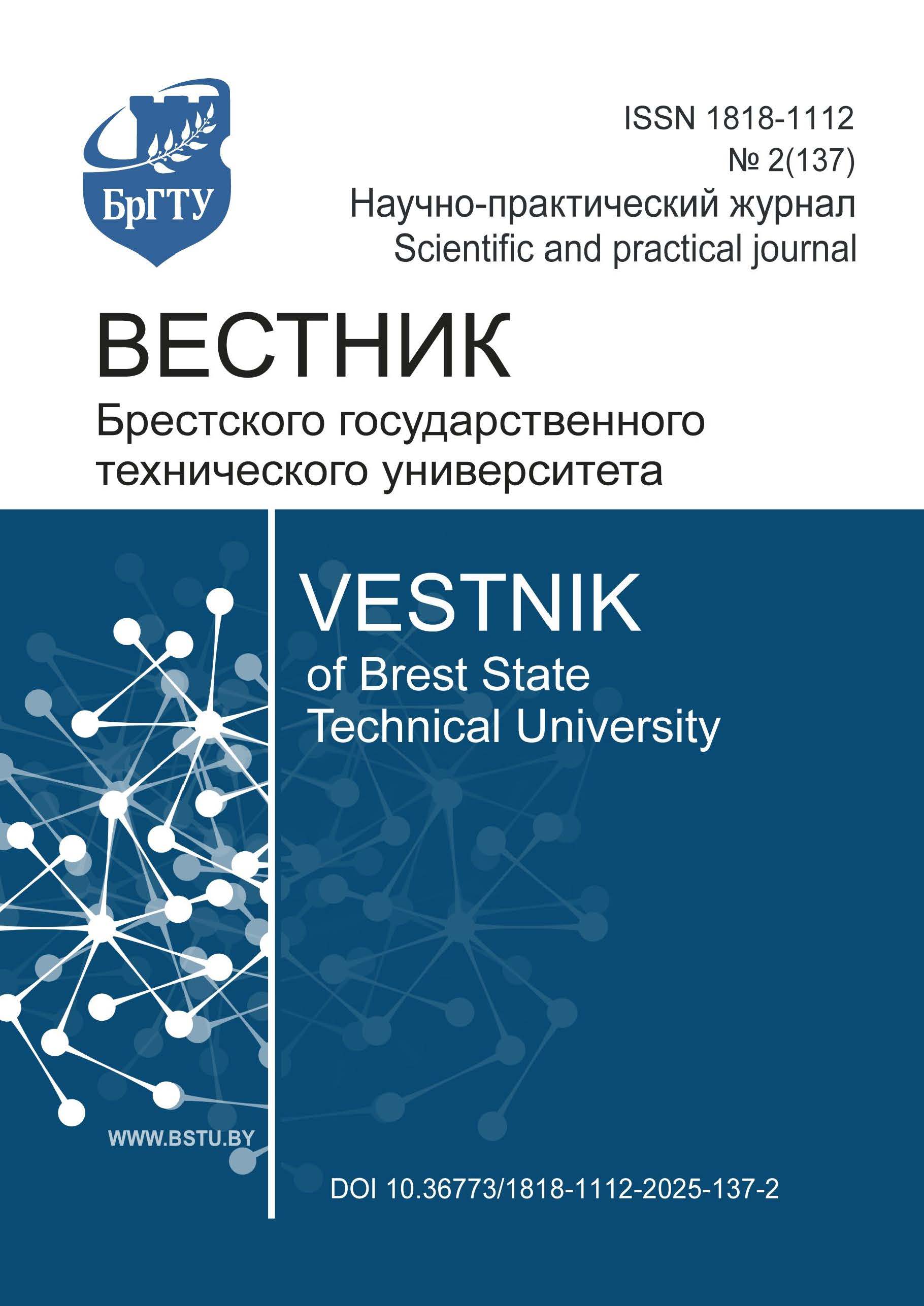ELECTROSPARK FLUORINE-CONTAINING COATINGS
DOI:
https://doi.org/10.36773/1818-1112-2025-137-2-68-72Keywords:
hybrid coatings, electric spark alloying, morphology, fluorine-containing oligomers, microhardness, corrosion resistanceAbstract
Currently, various types of coatings are used to increase the service life of machines and mechanisms. A new direction in the creation of hydride coatings is presented based on a combination of the processes of electrospark alloying of metal surfaces and subsequent treatment in solutions of surface-active fluorine-containing compounds. The aim of the research is to study the morphology and physical and mechanical characteristics of hybrid coatings formed by combining the processes of electrospark formation of hard coatings and subsequent treatment in a solution of a fluorine-containing surface-active substance. Steel P6M5 was used as a substrate for the formation of coatings. Electrodes W, T15K6 were used to form the coatings. Foleox F-5 with the structural formula Rf-CONHR2 was used to modify electrospark coatings when modifying the substrate. The studies were carried out using modern methods: scanning electron and optical microscopy, microdurametric analysis, NTR IR spectroscopy, profilometry, corrosion testing methods. It is shown that the process of hybrid coating formation allows to significantly increase the physical and mechanical characteristics of both the original metal substrates and the modified electric spark coatings. This effect of increasing the performance characteristics is expressed in the increase in the microhardness and corrosion resistance of the hybrid coatings. An increase in the microhardness of hybrid coatings by 12-15 % is observed in relation to traditional electric spark coatings. The process of increasing the microhardness of steel substrates and electric spark coatings when treated with fluorine-containing oligomers is due to the healing of microdefects on the surface of the samples under study and the formation of a strong chemisorption compound between the substrate (steel, EIL coating) and the organofluorine layers. The formation of these hybrid coatings will significantly reduce the friction coefficient and wear rate of the developed hybrid coatings.
References
Алгоритм выбора материала электрода при электроискровом легировании деталей / А. А. Богданов, В. В. Процив, С. Т. Пацера [и др.] // Вiсник Харкiвського нацiонального автомобiльно-дорожнього унiверситету : зб. наук. пр. – 2020. – Вип. 88, Т. 1. – С. 113–117.
Электроискровое осаждение Ti-Ta покрытий на титановый сплав Ti6Al4V: жаростойкость и трибологические свойства / А. А. Бурков, С. В. Николенко, В. О. Крутикова, Н. А. Шельменок // Физическая мезомеханика. – 2024. – Т. 27, № 3. – С. 159–168.
Гомжин, В. В. Электроискровое легирование стали 12Х18Н8Т комбинированным электродом В4С+CU / В. В. Гомжин, В. Л. Орлов, Ж. В. Еремеева // Cовременные материалы, техника и технологии. – 2023. – № 1 (46). – C. 23–27.
Физико-механические и трибологические свойства углеродсодержащих поверхностных нанокомпозитов, полученных электроискровым легированием / Д. М. Кройтору, С. А. Силкин, Н. Н. Казак [и др.] // Электронная обработка материалов. – 2020. – № 56 (6). – С. 12–23.
Коваль, А. В. Исследование коррозионного поведения покрытий, полученных на стали при электроискровом легировании ручным вибратором повышенной частоты / А. В. Коваль // Электронная обработка материалов. – 2021. – № 27 (1). – С. 44–51.
Казанников, О. В. Исследование механизированного способа электро-искрового легирования / О. В. Казанников // Образование и право. – 2020. – № 10. – С. 225–232.
Глушко, С. П. Исследование технологии электроискрового нанесения покрытий, легирования и упрочнения / С. П. Глушко // Advanced Engineering Research. – 2021. – Т. 21, № 3. – С. 253–259.
Овчинников, Е. В. Электроискровые углеродные покрытия / Е. В. Овчинников, А. Т. Волочко, А. Е. Овчинников // Актуальные проблемы прочности : материалы LXVIII Междунар. науч. конф., Витебск, 27–31 мая 2024 г. / под ред. В. В. Рубаника. – Минск : «ИВЦ Минфина», 2024. – С. 379–381.
Антифрикционные электроискровые покрытия для зубчатых передач / Е. В. Овчинников, В. И. Лунь, А. Ч. Свистун [и др.] // Горная механика и машиностроение. – 2024. – № 4. – С. 92–99.
Synthesis of Multicomponent Coatings by Electrospark Alloying with Powder Materials / V. Mihailov, N. Kazak, S. Ivashcu [et al.] // Coatings. – 2023. – Т. 13, № 3. – С. 1–14.
Овчинников, Е. В. Тонкие пленки фторсодержащих олигомеров: основы синтеза, свойства и применение / Е. В. Овчинников, В. А. Струк, В. А. Губанов. – Гродно : ГГАУ, 2007. – 326 с.
Овчинников, Е. В. Наноструктурированные фторсодержащие покрытия / Е. В. Овчинников // Фундаментальные и прикладные проблемы техники и технологии. – 2013. – № 2–3. – С. 60–67.
Триботехнические характеристики композиционных многослойных покрытий / Е. В. Овчинников, С. Д. Лещик, В. А. Струк [и др.] // Трение и износ. – 2000. – Т. 21, № 2. – C. 147–155.
Структурно-морфологические особенности тонких пленок фторсодержащих соединений на металлических подложках / В. А. Струк [и др.] // II Международный симпозиум по теоретической и прикладной плазмохимии : матер. симп-ма, Иваново, 22–26 мая 1995 г. / ИГХТУ; редкол.: С. Я. Шнайдер [и др.] – Иваново, 1995. – С. 291.
Struk, W. Besondeiheitender Struktur verschleiβfester schichten fluorhailtiger oligomere an metallen und polymeren / W. Struk, E. Owtchinnikow, O. Choladilov // Tribology – solving friction and wear problems: Proceedings of 10th International Colloqium, Esslingen, 09–10 jan. 1996 / Techische akademie Esslingen ; editor: W. J. Bartz. – Esslingen, 1996. – Vol. 3 – P. 1983–1988.
Downloads
Published
How to Cite
Issue
Section
License

This work is licensed under a Creative Commons Attribution-NonCommercial 4.0 International License.
The work is provided under the terms of Creative Commons public license Attribution-NonCommercial 4.0 International (CC BY-NC 4.0). This license allows an unlimited number of persons to reproduce and share the Licensed Material in all media and formats. Any use of the Licensed Material shall contain an identification of its Creator(s) and must be for non-commercial purposes only. Users may not prevent other individuals from taking any actions allowed by the license.










